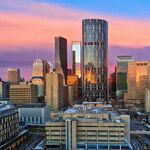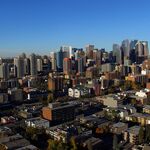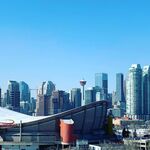Normally this is where I would point out that good inner city growth would help offset the need for new schools as we had plenty of inner city schools with capacity, but I don't know if that's the case any more. My son's schools, both elementary and junior high were at one time candidates for closure and now they've have run out capacity.
18 new schools and student spaces coming to Calgary and surrounding areas in Budget 2025 - LiveWire Calgary
Eighteen new schools are coming to Calgary and surrounding areas to address increasing enrolment pressures as part of Budget 2025 promises. According to a news release on Friday, the new schools will add 14,400 new and updated student spaces in Calgary, Airdrie and Chestermere. This brings the...livewirecalgary.com
You are using an out of date browser. It may not display this or other websites correctly.
You should upgrade or use an alternative browser.
You should upgrade or use an alternative browser.
Statscan numbers
- Thread starter kora
- Start date
trtcttc
Senior Member
Inner city schools are also generally older with less space to expand. The school by me can't accommodate many modular classrooms before encroaching on the limited field space. The decrease in population Canada-wide is going to show up in the interprovincial migration at some point. The pace of growth will slow, and as far as I know, the crunch is most acute in some grades (late middle, high school).Normally this is where I would point out that good inner city growth would help offset the need for new schools as we had plenty of inner city schools with capacity, but I don't know if that's the case any more. My son's schools, both elementary and junior high were at one time candidates for closure and now they've have run out capacity.
There's also a crunch for many elementary schools. Well at least the ones near to where I live. In some inner city neighborhoods the number of families with small kids has been on the rise, and with all of these small 4-16 unit developments popping up there will be more of that I think I'm also assuming at the same time there are other inner city areas that might not be seeing the same increase in families with young children.Inner city schools are also generally older with less space to expand. The school by me can't accommodate many modular classrooms before encroaching on the limited field space. The decrease in population Canada-wide is going to show up in the interprovincial migration at some point. The pace of growth will slow, and as far as I know, the crunch is most acute in some grades (late middle, high school).
I'm seeing a lot of increase in the north central neighborhoods like Capitol Hill, Mount Pleasant, Tuxedo, Renfrew etc..
DougB
Senior Member
Calgary could be the fastest growing metro both by percentage and in raw numbers of the next few years. I could see Toronto, KW, Montreal and Vancouver going negative for a year or two.Alberta grew by roughly 50K in Q1 and Q2 combined. Pretty decent growth considering Quebec, grew by 10K, Ontario grew by 5K. Man and Sask had pretty decent growth adding 6K and 7K respectively over those 2 quarters.
Que, Ont, BC all shrinking over the past quarter.
darwink
Senior Member
Here is toddler density per km²in the last census, if that is any guide.


CalgaryTiger
Senior Member
Holy look at the inner-city SW!
Good info. It confirms that I'm not imagining the increase in children for Mount Pleasant Capital Hill, Renfrew and Tuxedo. I don't know what it was like in previous years, but I bet those hoods were less green.Here is toddler density per km²in the last census, if that is any guide.
Also, how great is it seeing all that green in inner city SW.
Roaring Flames
Senior Member
Some green up in Beddington too! I've definitely noticed a lot of renos going on in the neighborhood in the past year (lots of big bins out front of houses). The 80+ year old next door neighbour just recently moved out after renos and the house sold within a week. The new neighbour is apparently going to be a young couple with a toddler.
Last edited:
Disraeli
Active Member
Note the correlation between areas with a lot of infill and older neighborhoods which are predominantly single family until recently.
CalgaryTiger
Senior Member
Question: Are the powers that be that plan schools aware of this and if so are they doing anything about it?
Answer: Maybe they're aware but they're not doing anything about it.
Answer: Maybe they're aware but they're not doing anything about it.
trtcttc
Senior Member
I think so but if you look at the highest green in that picture it's in the NE, and I imagine in the far NW / deep SE. Those areas are mostly school deserts, so that's why all the new schools are there.Question: Are the powers that be that plan schools aware of this and if so are they doing anything about it?
Answer: Maybe they're aware but they're not doing anything about it.
CalgaryTiger
Senior Member
The NE seems to have much more density than in the SE and North. I could be wrong but I imagine the density in those multiple dark green (500+ per sqkm) areas in the inner-city are much more dense than the sections that look to be New Brighton, MacKenzie Towne, and Auburn Bay. Which is why they're so small in comparison.NW / deep SE. Those areas are mostly school deserts, so that's why all the new schools are there.
Inner-City
SE
Every fall the CBE has a capacity crisis in the inner-city (I've posted Livewire articles about it) and a year goes by and they don't seem to do anything about it. Get creative, there are some small empty office buildings that could be used as a school. Probably would take a full school year to do but they could've started doing something about it. Like other things, Calgary is not the first place to have people living in dense areas, CBE can look at what other dense cities do for schools in the inner-city.
Albertasaurus
Active Member
The NE seems to have much more density than in the SE and North. I could be wrong but I imagine the density in those multiple dark green (500+ per sqkm) areas in the inner-city are much more dense than the sections that look to be New Brighton, MacKenzie Towne, and Auburn Bay. Which is why they're so small in comparison.
From seeing density maps of Calgary's neighbourhoods, densities in some parts of the NE (especially close to Saddletowne Stn) are easily the highest in the city outside of Beltline. Lots of multi-generational families which really impacts the population density up there.
darwink
Senior Member
In the NE for Saddletown, and the Deep SW, along 162nd, are viable '15 minute' cities that can support multiple grocery options (I think a useful metric lacking anything else).From seeing density maps of Calgary's neighbourhoods, densities in some parts of the NE (especially close to Saddletowne Stn) are easily the highest in the city outside of Beltline. Lots of multi-generational families which really impacts the population density up there.
CBBarnett
Senior Member
Love census mapper, really can see the redevelopment wave opening up areas to new families (while older areas that didn't have few toddlers and new families).Good info. It confirms that I'm not imagining the increase in children for Mount Pleasant Capital Hill, Renfrew and Tuxedo. I don't know what it was like in previous years, but I bet those hoods were less green.
Also, how great is it seeing all that green in inner city SW.
View attachment 661721
I like the census data because it can create counter-intuitive counter-points to prevailing themes and vibes that people think are true but are more nuanced. For example, in 2021 Greater Downtown (West Downtown, Commercial Core, Eau Claire, Chinatown, East Village, Beltline) has more toddlers (1,335) than Chestermere (1,305).
To some that's obvious given the relative population - but from a branding and how we all talk about "who the suburbs and downtown are for" it runs totally opposite to the mainstream myth that downtown is not for kids and families and kids only ever grow up in the burbs. Of course lots do, but it's hardly a universal truth.
Easy stuff to forget - we spend so much time worried about design and traffic safety on minor local roads in the sleepy burbs for kids, ignoring that we are totally fine with Downtown avenues being the way they are despite hundreds of children literally living on them.




